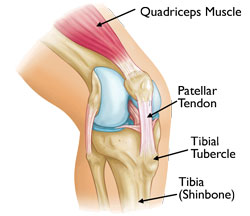This limited advice only applies to those types of injuries that are more common in pre- and early adolescent footballers and does not apply to obvious, traumatic incidents.
Osgood-Schlatter Disease (Knee Pain)
- Osgood-Schlatter disease is a common cause of knee pain in growing adolescents. It is an inflammation of the area just below the knee where the tendon from the kneecap (patellar tendon) attaches to the shinbone (tibia).
- Osgood-Schlatter disease most often occurs during growth spurts, when bones, muscles, tendons and other structures are changing rapidly. Because physical activity puts additional stress on bones and muscles, children who participate in sports – especially running and jumping sports – are at an increased risk for this condition. However, less active adolescents may also experience this problem.
- In most cases of Osgood-Schlatter disease, simple measures like rest, icing, stretching and strengthening exercises will relieve pain and allow a return to daily activities and football.

Osgood-Schlatter disease causes pain at the tibial tubercle – the bony bump where the patellar tendon attaches to the tibia (shinbone).
- The bones of children and adolescents have a special area where the bone is growing called the growth plate. Growth plates are areas of cartilage located near the ends of bones. When a child is fully grown, the growth plates fuse into solid bone.
- In the knee, the growth plates are also attachment sites for tendons (the strong tissues that connect muscles to bones). A bony bump called the tibial tubercle covers the growth plate at the end of the tibia. The group of muscles in the front of the thigh (called the quadriceps) attach to the tibial tubercle.
- While running and jumping, the quadriceps muscles pull on the patellar tendon, which in turn pulls on the tibial tubercle. In some children, this repetitive pulling on the tubercle leads to inflammation of the growth plate. The prominence, or bump, of the tibial tubercle may become very pronounced, swollen and sore.
- Painful symptoms are often brought on by running, jumping, and other sports-related activities. In some cases, both knees have symptoms, although one knee may be worse than the other.
- Treatment for Osgood-Schlatter disease focuses on reducing pain and swelling. This typically requires limiting exercise activity until players can enjoy activity without pain during, or significant pain after exercise.
- In some cases, rest from activity is required for several months, followed by a strength and conditioning program. However, if your child does not have a large amount of pain or a limp, participation in sports may be safe to continue.
- Early assessment and treatment from our physiotherapists can usually result in less missed time from training and playing.
Please note: this information should serve as a guide only. When in doubt always seek advice from Southside Physiotherapy & Sports Injury Centre or your GP.
